Hey there, fellow axe-wielders! Ever found yourself staring at a guitar, wondering, “Does The Shape Of An Electric Guitar Matter?” Well, you’re not alone. Some say it’s all about the looks, while others swear by the tone. But what’s the real deal?
I take a bit of a different approach than the people claiming that the shape of a solid-body electric guitar has no effect at all on tone and sustain, so this article is worth a read!
Grab your favorite pick, and let’s dive into the world of electric guitar shapes. Whether you’re a newbie strumming your first chords or a seasoned shredder, this guide is your backstage pass to understanding how the shape of your guitar can make you rock or leave you flat.
You can use the table of contents below to take you to the area that interests you. Click on the little box to open it, and then click on the section of the article you want to read, or you can read from start to finish if you want the full guitar-shape experience!
The Short Answer
The shape of the body, neck, fretboard radius, and headstock can all have a subtle and indirect effect on the tone and sustain of a guitar, but what matters most is the tonewood type and weight, as well as the pickups.The shape of each part contributes to the overall experience of playing the guitar. Whether you’re a beginner or a seasoned pro, understanding these aspects can help you find the perfect guitar that resonates with your style.
Keep On Reading (Below) To Learn More
The Anatomy Of An Electric Guitar
When evaluating the shape of a guitar, the four things I look at are the body, neck, fretboard, and headstock shape.
Body Shapes
There are a crazy number of electric guitar body shapes available. They’re like the guitar’s “personality,” shy, blends in well, or loud and outgoing.
These shapes each offer unique characteristics that can influence the guitar’s sound, playability, and aesthetics. From the classic curves of the Stratocaster to the aggressive angles of the Flying V, there’s a body shape to match every style and genre.
Here’s my take on some of the more of the ones I like to play:
The Stratocaster body shape is sleek and versatile, perfect for Blues and Rock. Following closely is the Telecaster, known for its bright twang and country flair.


The Gibson Les Paul, with its chunky and solid build, is a heavyweight champion of sustain, while the Gibson SG offers a lighter alternative with a devilish double-cutaway design.
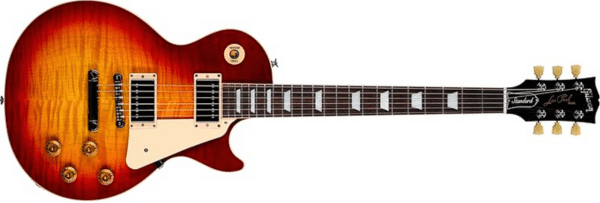

The Gibson ES-335 brings a touch of jazz elegance with its semi-hollow body.

The Gibson Explorer and B.C. Rich Warlock are the rebels of the bunch, with sharp and aggressive looks perfect for metalheads.

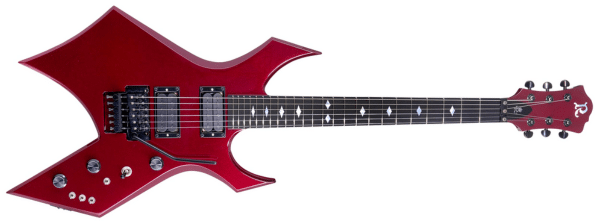
The Gibson Flying V is the rockstar of the group, with its iconic V-shape that screams rock ‘n’ roll.
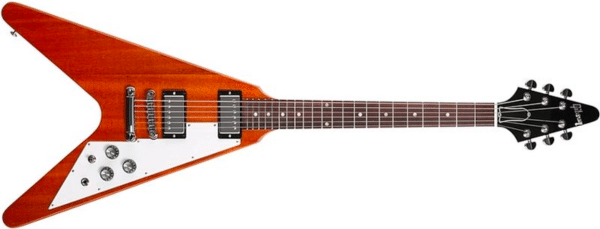
Lastly, the Parker Fly Deluxe offers a futuristic and ergonomic design for the modern player.
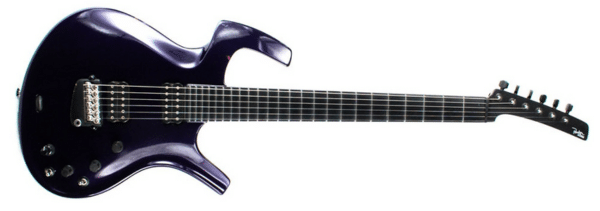
Neck Shapes
The neck shape is more than just a visual feature; it’s a crucial part of how the guitar feels in your hands. It’s like the “handshake” of a guitar. Each neck profile offers a different playing experience, allowing you to find the one that resonates with your style and technique.
- C-shape: is comfortable and friendly, like a good buddy’s handshake. It’s the most common shape and fits most hands, making it a go-to for many players.
– - D-shape adds a flatter back, offering a unique feel for those who like a faster playing experience. It’s like the sporty sibling of the C-shape, a bit more adventurous but still approachable.
– - V-shape is a bit edgier, for those who like to live on the wild side. It’s a unique feel that some players swear by, especially if it fits their hand.
– - U-shape is thick and robust, like a lumberjack’s firm grip. It offers great support for riffs and chords, making it a favorite among blues and rock players who like a substantial feel.
Here’s a great guitar neck chart from the Guitar Mill. They make outstanding instruments!

Fretboard Radius
The fretboard radius is like the “curvature of the road” on your musical journey. It’s all about how the fretboard feels under your fingertips.
- Flat: A flat fretboard radius is like the open highway, smooth and fast, allowing for quick solos and shredding. It might be less comfortable for chords, but it’s a favorite among speed demons.
– - Rounded: A rounded fretboard radius is like a winding country road, comfortable and natural for chords and rhythm playing. It might be a bit slower for shredding, but it’s perfect for those who love to strum and sing along.
– - Compound Radius: The compound radius is the best of both worlds, like a scenic route that’s both thrilling and relaxing. It combines a rounded radius near the nut for comfortable chording with a flatter radius towards the body for faster soloing. It’s the all-rounder for those who want versatility in their playing.
To learn more about fretboard radius, see my articles on:
7.25 VS 9.5 Inch Fingerboard Radius – Which Is One Is Better?
9.5 VS 12 Inch Fingerboard Radius – Which Is One Is Better?
Do Strats Have A Compound Radius? – What You Should Know!
Headstock Shapes
The headstock shape is like the “face” of your guitar, giving it a distinct personality. It’s not just about looks; it also affects the string tension and tuning stability.
3+3: The 3+3 headstock shape, often found on guitars like the Gibson Les Paul, offers a balanced and classic look. However, the less straight string pull can sometimes affect tuning stability, adding a bit of character to the guitar’s temperament.
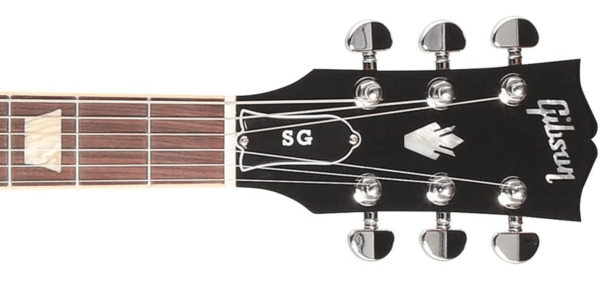
6-in-line: The 6-in-line headstock shape, commonly seen on Fender Stratocasters, provides a streamlined and modern appearance. It offers a more direct string path, but it can sometimes cause tuning issues, especially if you like to bend those strings like a rockstar.
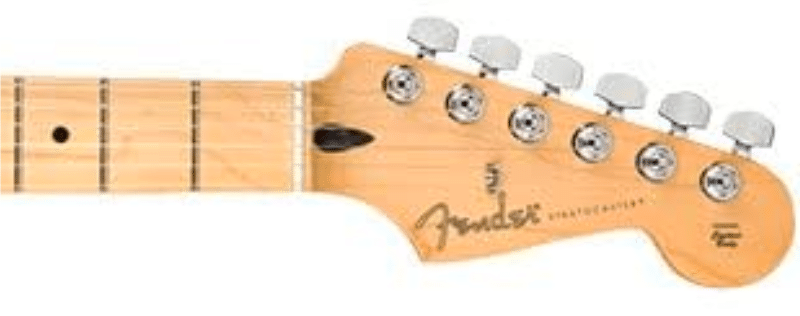
The fretboard radius and headstock shapes are essential aspects of a guitar’s playability and aesthetics. Whether you prefer the speed of a flat fretboard or the classic balance of a 3+3 headstock, understanding these features can help you find the guitar that sings to your soul.
Pros And Cons Of Various Guitars And Shapes
Just so you know, these are generalizations based on my playing experience with these guitars. Opinions may vary!


| Shape Type | Pros | Cons | Overall Playability |
|---|---|---|---|
| Body Shapes | |||
| Stratocaster | Versatile, Comfortable | Less Sustain | Great |
| Telecaster | Bright Twang, Classic Look | Less Comfortable | Very Good |
| Gibson Les Paul | Rich Tone, Great Sustain | Heavier | Very Good |
| Gibson SG | Light, Strong Tone | Neck Joint Delicate | Excellent |
| Gibson ES-335 | Warm, Elegant | Bulky | Good |
| Gibson Explorer | Aggressive Tone, Eye-Catching | Not Great for Sitting Down | Good |
| B.C. Rich Warlock | Metal-Ready, Striking | Impractical | Good |
| Parker Fly Deluxe | Futuristic, Ergonomic | Expensive | Excellent |
| Gibson Flying V | Iconic, Rock ‘n’ Roll Vibe | Impractical for Sitting | Excellent |
| Neck Shapes | |||
| C-shape | Comfortable for Most Hands | Less Support for Shredding | Excellent |
| D-shape | Fast Playing, Unique Feel | Not for Everyone | Very Great |
| V-shape | Unique Feel, Fast Playing | Not for Everyone | Good |
| U-shape | Supportive, Great for Riffs | Might Feel Bulky | Good |
| Fretboard Radius | |||
| Flat | Fast Playing | Less Comfortable for Chords | Very Good |
| Rounded | Comfortable for Chords | Slower for Shredding | Good |
| Compound | Versatile, Best of Both Worlds | More Complex to Manufacture, Higher Cost | Excellent |
| Headstock Shapes | |||
| 3+3 | Balanced, Classic | Less Straight String Pull | Very Good |
| 6-in-line | Streamlined, Modern | Can Cause Tuning Issues | Good |
How Shape Influences Sound

The shape of an electric guitar, including its body, neck, fretboard radius, and headstock, can indirectly and subtly contribute to its unique voice, affecting both tone and sustain.
While some aspects have a larger impact, others influence how we approach the instrument, leading to variations in tone and sustain.
Understanding these nuances can help you choose the right instrument for your style, sound preferences, and desired sustain.
The Influence Of Body Shape On Tone And Sustain
The body shape doesn’t significantly affect the tone of solid-body electric guitars. However, the thickness and mass of the body can influence both tone and sustain.
For example, a Les Paul, with its thicker body, tends to have a rich, warm tone and more natural sustain compared to a sleeker Stratocaster, which might have a brighter and clearer sound but less sustain.
The vibration of the strings is primarily picked up by the pickups, but the body’s mass can subtly prolong the vibration, enhancing sustain.
Hollow-Body Electric Guitars Are A Little Different
In hollow-body electric guitars, the shape and construction can create different resonances, affecting both tone and sustain. The sound waves bounce around inside the body, and the shape can create unique tonal characteristics and sustain, allowing notes to ring longer or die out more quickly.
Neck Shape’s Subtle Impact On Tone And Sustain
The neck shape doesn’t directly change the tone or sustain, but it can affect how we play, influencing both aspects.
For example, a “C-shaped” neck might encourage a more relaxed playing style, leading to a warmer tone and subtle variations in sustain, while a “D-shaped” neck might promote a more aggressive playing style and a brighter sound with more sustain.
Fretboard Radius And The Player’s Perspective
The fretboard radius, whether flat, rounded, or compound, affects the playability much more than the tone or sustain.
However, like the neck shape, it can indirectly influence these aspects by allowing for different playing styles.
A flat radius might enable faster playing, leading to a more aggressive tone with more sustain. In contrast, a rounded radius might encourage more rhythm-based playing, resulting in a warmer tone and potentially less sustain.
Headstock Shape Is A Subtle Nuance
The headstock shape can also have a subtle and minimal impact on tone and sustain. A 3+3 headstock might have a less straight string pull, which can add character to the guitar’s sound and slightly affect sustain, while a 6-in-line headstock might offer a more direct string path, leading to a more consistent tone and sustain.
The 3+3 headstock also gives less tension on the top (thinnest) three stings because they are closer to the nut, thereby changing the playability by making them easier to bend.
The Weight Factor
As stated above, an electric guitar’s weight can significantly impact tone and sustain. A heavier body can provide more sustain and a richer tone, while a lighter body might offer less natural sustain and a sharper tone.
Shape And Aesthetics: More Than Meets The Eye
Why It’s A Visual Symphony
You might not believe how many beginning players buy a guitar based on its shape and color alone, assuming it fits their budget, no matter how it plays and sounds! I did the same thing with my first guitar and remember the excitement well! It can be part of the excitement of starting your musical journey.
It’s part of the “coolness” of an electric guitar, right? It can make you feel cool and look cool to others. Lol. To learn more, check out my article on Cool Guitar Finishes – Is The Wow-Factor Your Main Criteria?
The shape of an electric guitar can be like a visual melody that captures the eye, especially if you are playing a gig in a small venue like a club. From the sleek curves of a Stratocaster to the aggressive angles of a Flying V, each shape tells a story and sets the stage for the music to come.
Genre And Iconic Players
Different shapes often become associated with specific genres and iconic players.
It’s hard to pick up a Stratocaster without thinking of Jimi Hendrix, Jeff Beck, Eric Clapton, and David Gilmour, to name just a few.
The Gibson Les Paul’s chunky body is synonymous with rock legends like Jimmy Page, Slash, and even the great Les Paul himself!
Whenever I see a Gibson SG, I think of Tony Iommi, Angus Young, and Frank Zappa.
The futuristic Parker Fly Deluxe might be seen in the hands of progressive rock virtuosos.
I’m sure you get the idea by now.
The Psychological Impact
The shape of a guitar can also have a psychological impact on both the player and the audience. A heavy metal-looking guitar might inspire a more aggressive playing style, while a classic Telecaster might evoke a sense of tradition and purity in tone.
Different colors on the exact shape guitar can also contribute to this effect. For example, a Flying V guitar painted bright red with yellow flames running up and down the body can beg to be played more aggressively than a Flying V with a Korina body and a natural finish.
Practical Considerations: Shape Meets Function
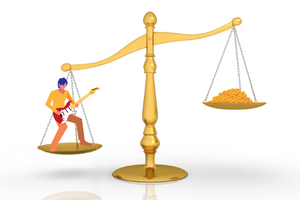
Practical considerations in the shape of an electric guitar can go beyond mere aesthetics.
From comfort and playability to accessibility and balance, the shape of a guitar can make the difference between a good playing experience and a great one. It’s about finding the perfect fit that allows players to express themselves fully without hindrance or discomfort.
Comfort and Playability: Finding the Perfect Fit
The shape of a guitar’s body can significantly affect how it feels against the player’s body. A contoured shape like the Stratocaster might hug the player’s body, providing a comfortable fit, while a more angular shape like the Explorer might feel less natural.
The shape of the neck plays a crucial role in hand comfort. A C-shaped neck might fit comfortably in the hand for rhythm playing, while shredders might prefer a flatter D-shaped neck.
The fretboard’s radius, whether flat or rounded, affects playability. A flatter radius might enable faster playing and bending, while a more rounded radius might feel more comfortable for chord playing.
Comfort and playability are highly personal. The playing style, genre, hand size, and personal preferences all play a role in finding the right shape.
Accessibility To Higher Frets
The design of the cutaways can influence the ease of access to higher frets. A double-cutaway design provides easier access to the upper frets, essential for intricate solos, while a single-cutaway or no cutaway might limit this accessibility.
Guitars like the Gibson SG offer the ultimate access to the highest frets. At the same time, something like a Telecaster’s single cutaway could make it more challenging to get your hand around the neck when playing above the seventeenth fret.
Balance And Weight
A guitar’s weight distribution, influenced by its shape, can affect playing comfort. A well-balanced guitar feels natural, whether standing or sitting, while a top-heavy or bottom-heavy guitar might cause strain over time.
If you’ve ever played a Les Paul guitar standing up for any length of time, you know what I’m talking about, even though this guitar is pretty well-balanced.
Choose Your Guitar Wisely!

Ah, the allure of a guitar with a body shape that screams “rock star!” It’s like spotting a flashy sports car and imagining yourself behind the wheel, wind in your hair, and all eyes on you. But wait, before you fall head over heels for that B.C. Rich Warlock or the rebellious Flying V, let’s pump the brakes and tune into reality.
Choosing a guitar based on its body shape alone is like picking a date for the prom based solely on that person’s dance moves. Sure, you might look great on the dance floor, but what if you can’t hold a conversation? Similarly, that wicked-looking guitar might look killer on stage, but what if it sounds like a cat in a blender or feels like wrestling a bear when you play it?
The moral of this rock ‘n’ roll fable? Don’t let the siren call of a sexy guitar shape lead you astray. It might look cool hanging on your wall, but if it doesn’t have the sound and playability you need, you might end up playing the blues instead of rocking out.
So, fellow guitar heroes, choose wisely. Let your ears and hands guide you, not just your eyes. Because when the stage lights dim and the crowd roars, it’s the music that matters, not just the shape of your axe.
Key Takeaways

Here are the key takeaways that encapsulate the most important points from the article.
- The shape of an electric guitar, including the body, neck, fretboard, and headstock, can play an indirect and subtle role in influencing its tone and sustain.
– - Cutaway designs and body shapes can either enhance or limit access to higher frets, affecting the ability to play intricate solos and reach the full range of musical expression.
– - When it comes to the tone and sustain of a guitar, what matters most is the tonewood type and weight, as well as the pickups.
Frequently Asked Questions

Here are some of the questions I get asked about guitar shapes.
If your question does not appear here, please put it in the comments, and I will get right back to you with an answer.
Is The Guitar’s Shape Related To Its Price?
While shape can influence aesthetics and brand identity, the price is more often determined by materials, craftsmanship, and brand reputation.
What Is The Most Famous Electric Guitar Shape?
Among the most famous electric guitar shapes, the Fender Stratocaster’s sleek and contoured design stands out as an iconic symbol in the world of Rock and Pop music.
Other notable shapes include the Gibson Les Paul’s solid and chunky body and the Telecaster’s timeless single-cutaway design.
Can I Design My Own Guitar Shape?
Yes, custom guitar builders can work with you to design a unique shape that fits your preferences and playing style.
Which Electric Guitar Shape Is Best For Beginners?
For beginners, an electric guitar shape that offers comfort and ease of playability is often recommended. Shapes like the Stratocaster are known for their contoured body and versatile sound, making them a popular choice among new players.
Which Electric Guitar Neck Shape Is Best?
The “best” electric guitar neck shape depends on the player’s hand size, playing style, and personal preferences. Common neck shapes like the “C” shape are often favored for their comfort and versatility, while a “D” shape might be preferred by those who play faster styles.
Can The Shape Of The Frets Affect Playing?
Fret shape can influence playability. Jumbo frets may facilitate bending, while smaller frets might offer more precise note control.
Why Are Electric Guitars Shaped Differently?
Electric guitars are shaped differently to cater to various musical styles, playing techniques, and personal preferences. Different shapes offer unique characteristics that resonate with players, from the sleek Stratocaster for Blues enthusiasts to the aggressive Flying V for Metalheads.
What Is The Best Shape For An Electric Guitar?
The “best” shape for an electric guitar is highly subjective. A shape that offers comfort and the desired tone for one guitarist might not be suitable for another. It’s essential to try different shapes and find the one that resonates with your playing style and musical preferences.
Final Thoughts

The question, “Does the shape of an electric guitar matter?” resonates with players of all levels. The answer is that the shape can have a subtle and indirect effect on the tone and sustain of a guitar, but what matters most is the tonewood type and weight, as well as the pickups.
So, the body shape can indirectly affect its tone and sustain by determining its mass, with different shapes offering unique sonic characteristics. For example, the thick body of a Les Paul provides more natural sustain, while the sleek Stratocaster shape is known for its comfort.
Practical considerations such as balance, weight, and accessibility to higher frets are all influenced by the guitar’s shape. Whether it’s the iconic curves of a Gibson SG or the ergonomic design of a Parker Fly Deluxe, the shape of an electric guitar is a complex interplay of form and function.
So, the shape of an electric guitar is far from a mere visual element. It’s a vital aspect that can subtly affect the sound, comfort, and expressiveness of the instrument, making it an essential consideration for every guitarist, from beginners to seasoned rock stars.
Here’s a video from Lucas Crossley Guitar that explains the important characteristics of a guitar neck, including the shape, radius, and scale length. Check it out!
What To Read Next ➡ Cool Guitar Finishes – Is The Wow-Factor Your Main Criteria?
Tell Me What You Think

Please leave a comment below if you enjoyed this article, have any questions about guitar shapes, or want to give your point of view. I will be happy to help you.
- How much do you think the shape of a solid-body guitar contributes to its tone and sustain?
- What’s your favorite electric guitar shape?
- How much does a different electric guitar shape affect the way you play the instrument?
- What else is on your mind?



I like your emphasis on the fact that the shape of the guitar contributes to the overall experience of playing the guitar. Although I am new on board; my preference is the D shape guitar. I dislike the V shape at all. I can assure you that I will complain when I have to use the V shape guitar. But overall, mastering the act and being flexible is the rule of the game.
Hi, Owoeye
Yes, I tend to favor the “D” shaped necks, too, especially for rock and Metal.
However, I have several guitars with “V” shaped necks, and I love the way they play and sound, especially for Blues. There are a variety of V-shaped configurations, including some which are barely V-shaped.
The key is to try playing a variety of neck shapes to find out how they feel in your hand and work with your playing style.
Rock On! 🤘
Frank 🎸
For any guitar enthusiasts, understanding the nuances of guitar shapes can truly elevate your playing and musical experience. It’s not just about the look but also how the shape can subtly influence the sound.
Given the various guitar shapes and their potential influence on tone, how would you recommend someone approach the process of selecting a shape when buying their first electric guitar?
Is there a particular shape you’d suggest for beginners?
I’m curious to know your thoughts. Thank you for sharing.
Hi, Eric
Thank You for your comments!
Most beginners start with an electric guitar shape that appeals to them or the shape that their favorite guitar hero uses.
I usually recommend that beginners go with the Fender Stratocaster or Gibson SG shapes because they both give easy access to the highest frets. They also have a great tone.
Rock On! 🤘
Frank 🎸